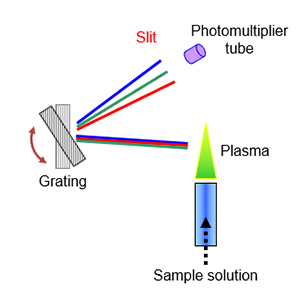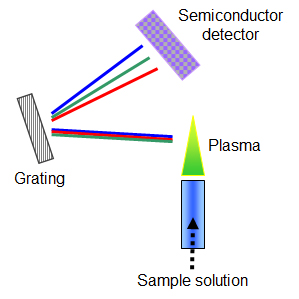- HOME
- Technical Information
- Commissioned Analysis and Research
- Inductively Coupled Plasma Optical Emission Spectrometry (ICP-OES)
Inductively Coupled Plasma Optical Emission Spectrometry (ICP-OES)
Principle
Inductively Coupled Plasma Optical Emission Spectrometry (ICP-OES) is an elemental analysis method that utilize emission from atoms and ions excited by ICP as an energy source. A sample solution is nebulized and introduced into an Ar plasma where atoms and ions are produced and excited by its energy. By dispersing emission from them in returning to the ground state, the species and amounts of elements can be evaluated from the wavelength and the intensity of detected emission, respectively.
The sample is limited to aqueous solutions for measurement by ICP-OES. Solid samples are need to be processed by appropriate chemical pretreatment.
There are two types of instruments based on differences in the spectrometer, sequential type and simultaneous type.
● Sequential scanning type
By swinging the diffraction grating, atomic emission is detected with respect to each wavelength by photomultiplier tube. High resolution in wavelength can be achieved, while only single wavelength is detected at a time.
● Simultaneous detection type
By using semiconductor detector such as CCD, multiple elements can be detected simultaneously, while the resolution in wavelength is inferior to sequential type.

